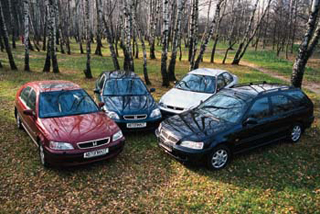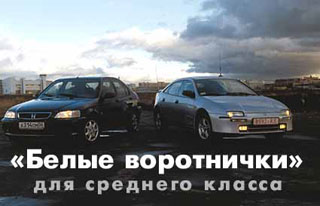Test drive Honda Civic Sedan 1995 - 2000 sedan
Filigree technology
There are several automobile companies in the world, even family models of which are traditionally distinguished by a sports image. In Italy, this is Alfa Romeo, in Germany - BMW, in Japan - Honda. How reasonable is this opinion, we decided to find out. Sivik is the most popular model of the Honda Motor concern: since 1972, more than 10 million cars have diverged around the world. In 1991, the family survived the change of model (ZR, 1996, No. 6), and already at the end of 1995 its thorough modernization was carried out. Sivik is released with four types of bodies: a three- and five-door hatchback, compartment and a four-door sedan. Highly phoned engines with a working volume of 1.4; 1.5; 1.6 liters in combination with a mechanical or automatic gearbox, as well as a stranded variator. The drive is front or permanent full.
Sivik is the most popular model of the Honda Motor concern: since 1972, more than 10 million cars have diverged around the world. In 1991, the family survived the change of model (ZR, 1996, No. 6), and already at the end of 1995 its thorough modernization was carried out. Sivik is released with four types of bodies: a three- and five-door hatchback, compartment and a four-door sedan. Highly phoned engines with a working volume of 1.4; 1.5; 1.6 liters in combination with a mechanical or automatic gearbox, as well as a stranded variator. The drive is front or permanent full. So, on the editorial test - the four -door Honda Sivik -1.5ILS sedan in a rather rich configuration - with ABS, two airbags, air conditioning, hatch, mirrors with electric drives, radio and branded alarms. The cost of a custom -made car in Moscow is $ 24,800.
The body is 4.3 points. The most striking element in the appearance of the 1996 sivik is huge eye headlights. Therefore, to identify the new Sivic is the easiest way in front: a low sloping hood, a relatively wide track at a small body height.
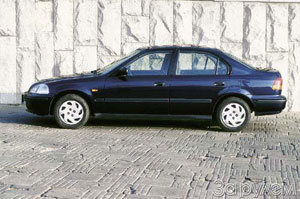 The quality of the assembly and coloring of the body did not cause comments: the gaps between the panels are uniform and minimal, the blue metallic shines in the sun.
The quality of the assembly and coloring of the body did not cause comments: the gaps between the panels are uniform and minimal, the blue metallic shines in the sun. The density of the doors leaves the thresholds and racks of the body clean, and the rubber edging of the door will protect you from painful contact with its upper angle. The doorways are large enough, but a strong slope of the roof racks will make the high passenger bother below.
Five people of medium complexion are accommodated quite comfortably, provided that the growth of the front riders does not exceed 180 cm. The seat belts are adjusted ahead in height, and at the back are hidden in special cracks in the seat pillow.
The trunk unlocks from the cabin or the key outside. Pretty spacious, but the high floor does not allow it to call it large. Maybe below there are a full -size reserve and an extensive set of tools? No, a thin dock, a jack and a screwdriver with a couple of keys, although there would be enough space for a tool box.
 The motor compartment is tightly filled with such items that garage craftsmen are powerless - you need good, modern service. Two almost the same radiators look unusual, one of which cools the air conditioner, a very narrow battery and small candles hung up in the engine head. The clutch hydraulic cylinders are miniature, the size of a finger, and the starter is not more than the wiper electric motor at some UAZ. In an unusual place - immediately behind the radiators - there is a catalytic neutralizer (its effectiveness directly depends on the temperature of exhaust gases). One trifle finally finished us: the hood emphasis is specially weakened by Stampovka, on which he will bend, if you try to slam it in a hurry, the mistake will not turn into more serious damage.
The motor compartment is tightly filled with such items that garage craftsmen are powerless - you need good, modern service. Two almost the same radiators look unusual, one of which cools the air conditioner, a very narrow battery and small candles hung up in the engine head. The clutch hydraulic cylinders are miniature, the size of a finger, and the starter is not more than the wiper electric motor at some UAZ. In an unusual place - immediately behind the radiators - there is a catalytic neutralizer (its effectiveness directly depends on the temperature of exhaust gases). One trifle finally finished us: the hood emphasis is specially weakened by Stampovka, on which he will bend, if you try to slam it in a hurry, the mistake will not turn into more serious damage. Let's look under the car. The engine and lower front suspension levers are installed on a subframe suspended on rubber supports. In the front wheel niches - plastic shelters. The gas pipelines and brake tubes on the bottom are covered with a casing, the exhaust steel system is partially shielded. And here is the explanation of the high floor in the trunk - a huge barrel of the muffler, which looks more appropriate on some road cruiser.
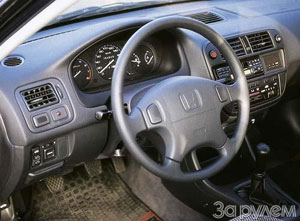 The driver's workplace is 4.1. First of all, we adjust the seat - it has the height of the pillow, but it itself could be more authentic. You can raise or lower the pleasant to the touch, the rough steering wheel. The pedals are located conveniently, in one plane, and the distances between them are such that you do not catch the radar of the winter boots. A platform for the rest of the left leg is also provided. The handle of the gearbox itself lies in the hand, the switching is very clear. The algorithm is familiar - as in Zhigulevskaya classic with a five -speed box.
The driver's workplace is 4.1. First of all, we adjust the seat - it has the height of the pillow, but it itself could be more authentic. You can raise or lower the pleasant to the touch, the rough steering wheel. The pedals are located conveniently, in one plane, and the distances between them are such that you do not catch the radar of the winter boots. A platform for the rest of the left leg is also provided. The handle of the gearbox itself lies in the hand, the switching is very clear. The algorithm is familiar - as in Zhigulevskaya classic with a five -speed box. The visibility of forward and the sides is excellent, but the inner mirror is not enough: the viewing sector is less than the rear window allows. In addition, from below, the picture is tangibly pushed by the head restraints of the back row of seats and the body of an additional stop signal.
Movement - 4.6. The control lamps blinked, a thoroughbred, with a whistle, sound appeared under the hood. What is the engine stalled? No - the arrow of the tachometer near the mark 700. The engine balanced and the sound insulation of Honda are such that, having forgotten, sometimes you try to let the already working motor.
The start and dynamics of acceleration at the first moment was puzzled - the engine seems to do not collect thirty horses from the declared one hundred and fourteen. However, recalling his characteristics, I immediately catch myself on a mistake-I accelerated in Zhiguli, promoting the engine to three or four, and he loves higher speeds. Let's try again...
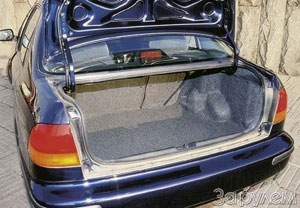 The first gear is gas to the floor. With a light slip, Honda breaks down. The speed of thirty, forty, fifty, sixty ... The beautiful sound of the engine seems to spur - come on, press! At 6800 rpm, the tachometer arrow rests on the red sector and a revolutionary limiter is triggered, although it seems that they can be recruited more and more, twisting this voiced power from the motor. Already in second gear, the speedometer easily goes over a hundred. Acceleration is powerful and even, without pronounced pickups.
The first gear is gas to the floor. With a light slip, Honda breaks down. The speed of thirty, forty, fifty, sixty ... The beautiful sound of the engine seems to spur - come on, press! At 6800 rpm, the tachometer arrow rests on the red sector and a revolutionary limiter is triggered, although it seems that they can be recruited more and more, twisting this voiced power from the motor. Already in second gear, the speedometer easily goes over a hundred. Acceleration is powerful and even, without pronounced pickups. Sivica control is light, almost airy. The pedals are soft, the steering wheel can be twisted literally with two fingers - a hydraulic booster in the list of standard equipment. On the road, the car holds tenaciously - sensitively reacting to the slightest turn of the steering wheel, it seems to predict your desires. The turns are held with minimal roll, obediently prescribing the given trajectory. And even in risky turns, at the limit of the adhesive qualities of the wheels, is very reliable and predictable. The potential of the machine allows you to install a motor and more serious - with a volume of only 1.6 liters, but with a capacity of 160 forces! But we will not be distracted.
In the sports, a hard, short-flowing suspension does not ignore joints and potholes, although this does not cause much inconvenience. She literally licks more smooth irregularities, ensuring reliable contact of the wheels with the road.
T
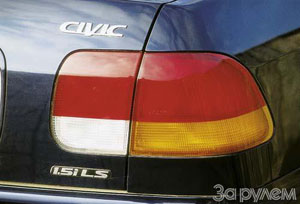 ormosis is effective, and here also ABS - even when braking in a slippery turn, you will not lose the car.
ormosis is effective, and here also ABS - even when braking in a slippery turn, you will not lose the car. It is difficult to complain about outer lighting equipment - powerful headlights, bright lanterns. Unless the place for the headlight corrector is not chosen the most successful - on the floor tunnel, between the front seats. Yellow backlighting the dashboard - without a brightness regulator.
External vibrations and noise into the salon almost do not penetrate. Only the rustle of the tires on the rough coating and bo-bo at the joints of the plates.
Operation, prices - 3.9. Honda engines are very economical. Our VTEC is equipped with a Honda system, which changes the lifting height and the opening phase of the intake valves, which allows you to use the impoverished mixture at low speeds. On thirty liters, we drove more than four hundred kilometers, including Moscow traffic jams.
A highly substituted engine needs oil guaranteed high quality - do not try to improve it with different additives. In the instructions for the car there is a reservation on this score: your sivik does not need any special additives to the oil. The replacement is prescribed after 10 thousand kilometers or six months, but with a note that under extreme conditions, these intervals are halved. Under extreme conditions, the Japanese understand frequent trips at short distances, dust, frost, salty, broken and dirty roads. What is there - the puncture of the wheel is attributed to emergency situations and the description of its replacement is dedicated to five (!) Pages. So by civilized standards, our whole life is a continuous extrem.
 For cars sold in Russia, a guarantee is a year without limiting a run. Sivica speaks of the reliability of this fact - imported four years ago for a hundred batch of ball supports has not yet been sold. Honda warranty and current maintenance is carried out by the only branded service station in Moscow, where one norm is estimated at $ 50.
For cars sold in Russia, a guarantee is a year without limiting a run. Sivica speaks of the reliability of this fact - imported four years ago for a hundred batch of ball supports has not yet been sold. Honda warranty and current maintenance is carried out by the only branded service station in Moscow, where one norm is estimated at $ 50. And here is the cost in dollars of some spare parts for Sivik at the same station: Block Fara - 333; Radiator cladding - 95; hood - 502; front wing - 223; Bumpers - 688; rear light - 157; front windshield - 582; filters: air - 37, oil - 22, fuel - 89; brake pads: front - 183, rear - 144; Shrus assembly - 656.
The cheapest Siviks sold in Russia - a three -door hatchback with a half -liter engine and a mechanical gearbox - costs 21,500 dollars. A four -door sedan in a similar configuration is already 23,300 dollars. The most expensive modification with an automatic gearbox will cost 25,900. It is unlikely that you will find another such thoroughbred and reliable car for that kind of money.
This is not a mirror in an inverted picture - the Sivica engine is really located on the left along the way, and the gearbox is on the right.
Access to a medium -sized trunk is simply excellent, and its volume can be increased by folding the back of the seat (2: 1).
Excellent ergonomics of the driver’s place and easy control will make every trip pleasant.
X-ray picture of Honda Sivik with a body of a three-door hatchback.
From the stern, the sedan is similar to many other cars - it is difficult to identify it.
+
Excellent stability and handling
Great engine
Clear work of the gearbox
Easy control
-
Suppose only unhealthy gasoline
Small clearance
Technical characteristics of the Honda Sivik-1,5LS car
 General data: number of places - 5; Equipped mass - 1100 kg; full weight - 1600 kg; maximum speed - 192 km/h; acceleration time from a place to 100 km/h - 10.4 s; fuel consumption at 90, 120 km/h and Hz - 4.8; 6.2; 6.6 l/100 km; fuel supply - 45 liters; Fuel - unhealthy gasoline with an octane number 91. Dimensions, mm: length - 4460; width - 1695; height - 1390; base - 2620; The track in front/back - 1478/1487; clearance - 108; The turning radius is 5.4 m. The engine: gasoline, with distributed injection, four -cylinder, in -line, sixteen -valve, with a variable valve lifting height, is located in front of the front. Working volume - 1493 cm; cylinder diameter and piston stroke - 75x84.5 mm; compression degree - 9.6; Power - 84 kW/114 hp at 6500 rpm; The maximum torque is 138 N.M at 5200 rpm. Transmission: drive - on the front wheels; gearbox - mechanical five -speed; Transporting numbers: I - 3.25; II - 1.78; III - 1.25; IV - 0.94; V - 0.70; Z.Kh. - 3.15; The main program is 3.89. Suspension: the front - independent, on double transverse levers with a spring -loaded resistance and a reptile stability stabilizer; The back is independent, spring, on longitudinal and transverse levers. Brakes: hydraulic, with a vacuum amplifier, front - ventilated disk, rear - drum. Steering: rheck with a hydraulic wrap. Tire size: 175/65R14.
General data: number of places - 5; Equipped mass - 1100 kg; full weight - 1600 kg; maximum speed - 192 km/h; acceleration time from a place to 100 km/h - 10.4 s; fuel consumption at 90, 120 km/h and Hz - 4.8; 6.2; 6.6 l/100 km; fuel supply - 45 liters; Fuel - unhealthy gasoline with an octane number 91. Dimensions, mm: length - 4460; width - 1695; height - 1390; base - 2620; The track in front/back - 1478/1487; clearance - 108; The turning radius is 5.4 m. The engine: gasoline, with distributed injection, four -cylinder, in -line, sixteen -valve, with a variable valve lifting height, is located in front of the front. Working volume - 1493 cm; cylinder diameter and piston stroke - 75x84.5 mm; compression degree - 9.6; Power - 84 kW/114 hp at 6500 rpm; The maximum torque is 138 N.M at 5200 rpm. Transmission: drive - on the front wheels; gearbox - mechanical five -speed; Transporting numbers: I - 3.25; II - 1.78; III - 1.25; IV - 0.94; V - 0.70; Z.Kh. - 3.15; The main program is 3.89. Suspension: the front - independent, on double transverse levers with a spring -loaded resistance and a reptile stability stabilizer; The back is independent, spring, on longitudinal and transverse levers. Brakes: hydraulic, with a vacuum amplifier, front - ventilated disk, rear - drum. Steering: rheck with a hydraulic wrap. Tire size: 175/65R14. The press about Honda Sivik
In the USA, Sivik is one of the most popular compact class cars. Its pluses include excellent quality, good ergonomics, an economical and balanced engine, the cleanliness of the exhaust of which meets the tough California norms of 2000. The machine has a moderate price - $ 12752 for a three -door hatchback and a fairly high secondary cost. The Americans did not like insufficient lateral support and short seats.
The Germans approved the chassis and the engine, considering still insufficient torque at low speeds. The brakes seemed to them prone to overheating.
The British liked the incredible economy, excellent quality, comfortable suspension and rich equipment in standard configuration. I did not like the appearance, interior design and price - in England at least 13,495 pounds.
In a nutshell, the verdict of the foreign press is as follows: Honda Sivik is perhaps the most perfect car in its class, but it is difficult to love it.


Yuri Nechetov
Photo by Vladimir Knyazev
Source: The magazine "Driving"
Honda Civic Sedan 1995 test drives - 2000
Honda Civic Crash Test Sedan 1995 - 2000
Krassh Test: Detailed Information18%
Driver and passengers
3%
Pedestrians





